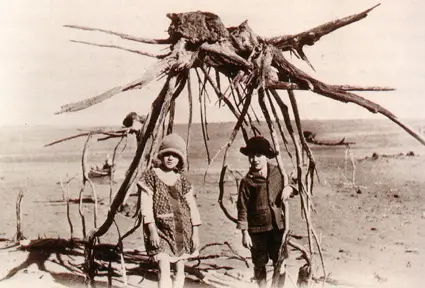A drought is a period of unusually persistent dry weather that persists long enough to cause serious problems such as crop damage and/or water supply shortages. The severity depends upon the degree of moisture deficiency, the duration, and the size of the affected area.
The major effects of climate change on water systems take place through changes in the hydrological cycle, basically the balance between temperature, and rainfall. Whilst some regions may have higher rainfalls this can evaporate through sustained increases in temperature. The El Niño is strongly linked to droughts, and is a disruption of the ocean-atmosphere system in the Tropical Pacific which has important consequences for weather and climate around the globe.

Image: Mallee District in Australia 1920s, Victorian Department of Conservation, Forests and Lands. Drying out of the countryside and land degradation is graphically shown in this picture. The roots of this long dead Mallee tree were once below ground level.
Dr Pittock, who is the retired leader of the Australian CSIRO Climate Impacts Group says, “The present drying trends in southwestern Australia and possibly those in southeastern and eastern Australia are partly attributable to human-induced climate change. They result from warming which is increasing evaporation in catchments, and in some cases, leading to a decreasing trend in rainfall.” He also says, that unless the basic cause of globally increasing greenhouse gas emissions from the burning of fossil fuels is dealt with, periods of water shortage and drought will become more frequent and severe.
The climate system will respond to the present increases in emissions over many decades to come. This is because there is a lag-period between the time when carbon dioxide is emitted and the worsening situations that will occur decades into the future as a result of these emissions.
WWF, the global conservation organization, warns about the rate of retreat of Himalayan glaciers. The world’s highest glaciers are receding at an average rate of 10 to 15 meters (33 to 49 feet) per year, a rate that is accelerating as global warming increases. Eventually this will mean water shortages for hundreds of millions of people whose water supplies will dry up as the glaciers melt and flow down the rivers to the sea.
Climate change in the already arid African northern sub-region is expected to enhance desertification and bring a gradual decrease in forest cover. In the Sahara and Sahel sub-regions, rainfall is predicted to drop, resulting in soil degradation and an increasing number of dust storms and drought. In northeast Africa, more intense dry periods and shorter wet seasons are expected to affect even huge river systems such as the Blue Nile, leading to serious water shortages and adverse consequences for the agriculture and forestry sectors throughout the region. East and Central Africa will also see its agricultural capacity decline. In West Africa, more frequent and longer dry periods are expected, again threatening crop failures.

